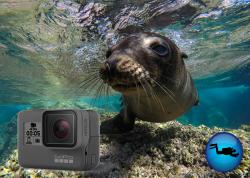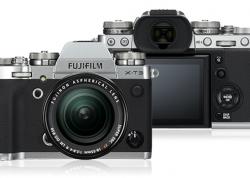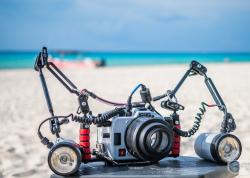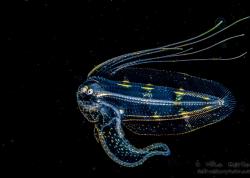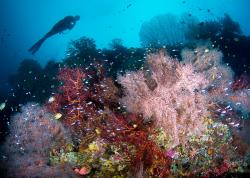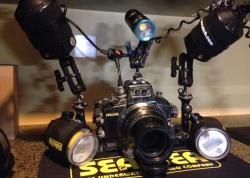Sea & Sea MDX-D7100 Housing Review
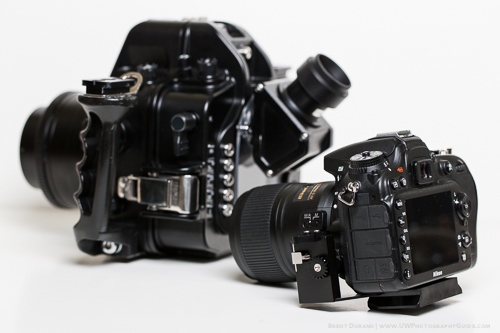
After 5 years of solid and reliable use of my Nikon D300 and D300s camera & housing systems, I finally decided it was time for an upgrade. The new addition to the family would need to be a step up in capabilities and not just an increase in pixels. The choice wasn’t an easy one, as I have been holding out for the “New D400” or the next generation in the Prosumer Nikon camera lineup that isn’t full frame. My decision to purchase the D7100 over the other Nikon options was based purely on my needs as an underwater photographer, my shooting style and what would serve me the best.
Disclaimer: I purchased both camera and housing and am not being paid by either Nikon or Sea and Sea for this review and for those reasons I will be very candid in my findings. The topside capabilities of the D7100 have already been discussed in UWPG’s Nikon D7100 camera review, so I’ve focused on specific features used in underwater photography followed by the Sea & Sea housing review.
Part I: Nikon D7100 Review for Underwater Photography
Part II: Sea & Sea MDX-D7100 Review (click to jump to housing review)
Part I
D7100 Camera Specs at a Glance:
Pixels: 24.1 Million megapixels
Image Sensor Size / Type: DX Format, CMOS Sensor @ 23.5mm x 15.6mm
ISO 100-6400 expandable to (ISO-25,600)
Media: 2 SD-Card slots for memory
Video capabilities: HD 1080 with live focus capabilities
Long battery life
More detailed camera specs are available in the D7100 camera review.
Field Testing the D7100
This review is conducted as a series of challenges based on the way I used my camera system during a 2-week period.
Challenge 1: Macro
My primary style of photography leans heavily on macro photography. I enjoy capturing smaller critters with vibrant backgrounds in a natural setting. Often times this means the background is drab, so I rely heavily on my lighting and f-stops to make the subjects jump out. I also don’t like to crop, which is the main motivation in selecting a smaller sensor.
Finding: The images shot with my 60mm macro lens and my Sigma 28-80 macro lens are all very color rich with a color depth increase from 22.5 (with D300) to 24.2 (D7100). Color depth (aka bit depth) describes the distinct colors represented by each pixel (bits per pixel). The quality of the images captured and the detail are very great overall. Noise begins to creep in when the images are greatly expanded but for media purposes or even large prints this is negligible.

Challenge 2: Super Macro
These shots use a 105mm lens with +5 or +10 diopters, providing a magnification ratio greater than 1:1 with no cropping. The super macro challenge needs to be subjected to 2 separate factors:
Ease of use, the mechanics of how I/others will use this system to capture super macro.
Image quality
Ease of Use: To capture images of the very small critters like Hairy shrimp, Popcorn shrimp, Skeleton shrimp etc., I use AE-Lock lever to “Focus Lock” and fire. Oftentimes I will also slip the camera into manual focus, rack out the lens and moving the camera back and forth to find sharp focus. All of these functions are accessible through levers on the Sea & Sea housing and I can access them without having to remove my hands from the system.
Image Quality: The vibrant colors, detail and contrast are the first things that I noticed once the images were on a large monitor. There has been some chatter on the Internet about diffraction at higher F-stops, but based on my findings the diffraction is a non-issue for underwater photo contests or publications.
.jpg)
Challenge 3: Wide-Angle
Shooting wide angle is always a challenge for me. Backscatter is a constant, proper lighting is difficult to achieve and the list goes on. I have concentrated on landscape wide-angle images to see how this pixel packed sensor handles the colors and the noise from edge to edge.
Finding: The D7100’s CMOS sensor handles noise well in the strobe lit foreground but begins to show more noise as it transitions into the dark areas of the images. Sun balls are tight and easily controlled with very slight contrast banding seen in the jpeg images (RAW shooters can ignore this). Sharpness from the front of the image to the back remains fairly detailed with very little loss of information. For testing purposes, when shooting in low light without strobe flash at ISO 320, the photos became a little grainy when magnified at 100%.
Looking closely at the corals (100%) in the foreground will give the viewer some indication of the noise levels.



Challenge 4: Close Focus Wide-Angle
Oftentimes I shoot light-colored subjects in the foreground that often get blown out, lose contrast and lose detail. As a result, this requires close attention to the highlights in the foreground while capturing a wider angle of view and appropriate ambient light in the open water background. Naturally, photographers will use of higher F-stops and the D7100 steps up to the challenge.
Finding: CFWA was a breeze when shooting with the Tokina 10-17 lens. Using spot focus helped me to gain an edge as the bright background can distract the focus on other settings. The subtle details all come through well without losing any significant highlights. I was particularly pleased with the way the sunlight came through in the reefscape below. My guide recognized the photo opportunity, moved quickly into the sun and over me, allowing this shot to happen very quickly. The ergonomics of the D7100 and Sea & Sea housing allowed for quick settings adjustments during the fleeting moment.

Challenge 5: Afternoon Light and Autofocus
Afternoon light underwater will put any camera’s autofocus to a real test. For this challenge I chose to photograph fast-moving flasher wrasse, which live over shallow broken rubble. Photographing one of these lovely creatures while flashing demanded 100% of my concentration and quick work with the camera and lens (the 105mm for shooting long). The dipping sun and long shadows of the afternoon suck the color away from the reefs, and these fussy fish shy away from modeling lights, creating challenging shooting conditions.
Finding: The D7100 performed well without a modeling light and lack of contrast. The autofocus on the 7100 is fast, (measurably faster than the D300) so I have been enjoying the challenge of shooting fast-moving subjects. One of the housing features of all Sea & Sea MDX housings is the AE-Lock lever controlled with the thumb. I use this to lock focus and to quick focus on fast moving subjects. There is also a 3D auto track feature on the D7100 that assists in tracking your subjects. I highly recommend using these features for fish photography, especially in low light.

Challenge 6: Night Dives
Focus light power (lumens) can play a significant role in how a camera functions at night, and I noticed a big improvement from the D300 to the D7100. In the past I used my 60mm lens nearly exclusively on night dives primary for its fast focusing capability.
Finding: With the D7100, I decided to use the 105 to see how the camera / lens combo would focus at night. The D7100 rose to the occasion. Fast, sharp focus on small subjects is obtained when lit with a variety of focus lights (varying power in lumens). This is particularly important to me as it means no further investments in costly focus lights.

Challenge 7: Fluoro Photography
Underwater fluoro (blue light) photography demands shooting at higher than normal ISO ranges (1600 and up) with an intense blue modeling light and filters. Digital noise control would be apparent right away, and shooting the photos through a range of settings would reveal how the D7100 functions in this challenge.
Finding: Pleasantly surprised at both the digital noise and as an extra bonus, the ability to use my 105mm lens with fluoro light. The noise control exceeds that of the D300 and 300s without any question, and the 105mm was easy to use at the higher ISOs.


Video with the D7100 & MDX-D7100
(Video test contributed by UWPG editor Brent Durand)
The Nikon D7100 shoots HD video with full manual control. The camera must be set to Live View before video can be recorded. As with all DSLR video, using autofocus is not ideal since the contrast detect autofocus systems used in Live View are nowhere near as sophisticated as the phase detection systems used when shooting through the viewfinder. This is why serious videographers rely on manual focus.
The video below was shot handheld (no tripod for stabilization) using autofocus in order to test the autofocus system with the Nikkor 60mm lens.
The D7100 performed well, and the Sea & Sea MDX-D7100 housing made it easy to focus by half depressing the shutter lever (to activate autofocus) before pressing the red video record lever.
MDX-D7100 Video Test - Handheld with Autofocus
D7100 Field test results
Pros:
I think that the Nikon D7100 is a definite upgrade from the D300 and the D300s. It outperformed my D300’s in several categories as listed above and even surprised me a bit. The most significant find for me is the D7100’s ability to quickly focus in low contrast situations and the overall performance in low light capabilities. The dynamic range for bright sunlight and ambient shooting along with the ease of handling large files are also a bonus.
Cons:
Digital Noise is my biggest concern with the D7100 and the images that it’s producing. I tend to look deep into the photos (pixel peeping) to find these flaws so that I can continually improve image composition and lighting on a frame-to-frame basis. With the megapixel-packed high performance D7100 the images tend to be a bit noisy, however the detail is also stunning. It’s a fair trade off in the long run and I have to say the image quality is at least 15-20% superior to that of the D300/s.
The overall images produced by the D7100 are inline with any high performance consumer grade camera. It will fill the need for any publication, print size or internet posts. The system is a value at the market price and leans heavily towards a professional grade system.

Part II
Housing Review:
Sea and Sea MDX-D7100
Sea & Sea housings have endured my special blend of abuse over the years. As an example, one of my D300 housings has bounced off of the hull of a moving boat without a catastrophic flood. This dependability and reliability made my choice to match the D7100 with a Sea & Sea MDX-D7100 housing a no brainer.
Sea & Sea housings are known for solid engineering, reliable manufacturing, excellent design and being well built. Sea & Sea has been a pioneer and leader in the industry for many years and has lived up to their great reputation once again in the MDX-D7100 housing. The design allows the user full control over the camera system without being over-engineered. The housing remains light and ergonomic even with the addition of some new features. Machined from aluminum, the housings are field-tested and tough with a low fail rate (barring human error).
MDX-D7100 Housing Specs
Fiber optic plugs-TTL compatible with YS-D1 strobes and YS 250 pros
Camera strobe pop-up and close button/lever
External Port lock/unlock for quick changing lenses-New feature
Info illumination button
Large LCD viewing window
F-stop knob
Shutter speed/command dial
Review lever
Video lever
Quick auto ISO
Visual leak detector
Audible Leak Detector
Use Sea & Sea Optical YS Converter for TTL Strobe Power
These main features are easily and naturally accessible for active shooting, and there are more passive functions also available at your fingertips.
CONSTRUCTION: Body – corrosion-resistant aluminum alloy (machined)
DEPTH RATING: 100m / 330ft
DIMENSIONS (WxHxD): 341 x 192 x 136mm / 13.4 x 7.6 x 5.4 inches
WEIGHT: Approx 2,700g / 94.5oz (housing only)

.jpg) Left: Colorful reefscape. Right: Vivid detail of a cuttlefish.
Left: Colorful reefscape. Right: Vivid detail of a cuttlefish.
MDX-D7100 In the Lab
(In the Lab section contributed by UWPG editor Brent Durand)
New MDX-D7100 Features & Benefits
- New Lens Lock release button and port lock allows you to change lenses/ports without removing camera from the housing.

Optional built-in Optical YS Converter/N converts camera’s TTL signal into a light signal. Easily switch between manual and TTL modes from outside the housing, with easy power level adjustments. Blue and green lights let the diver know which mode they are currently using.

Compatible with both VF180 1.2x and VF45 1.2x viewfinders. Both viewfinders provide a 1.2x magnification ratio with full field of view.

New handle design is more travel-friendly, with threadless fixings to facilitate easy transportation, mounting and removal.

Built in leak sensor.

Multi selector designed and operated in the same way as the camera control.

Recording video is easy with the MDX-D7100. The Live View button is easy to access (if not already in Live View mode) and the red video lever is easy to press. For those shooting with autofocus - the shutter lever is a bit close to the video record lever, making it a little challenging to focus with the shutter lever while starting/stoping recording.
MDX-D7100 Impressions from the Water
Setting up the housing for use is a simple plug-and-play, and once the camera mount is in place at the base of the camera body, all that is left is port selection based on lens. The three most important controls for any underwater photographer are ISO, Shutter Speed and F-stop, and each of these three command dials are at your fingertips. I particularly like this fact, as I don’t need to go into the camera’s menus or make double use of any button/knobs for quick adaptive changes. This allows me to keep my hands on the camera and an eye in viewfinder.
An unexpected bonus worth mentioning is the ability to use the camera’s on-board TTL instead of a TTL converter. When using sync cords in the past, a TTL converter was needed to fully control the strobe power (when shooting TTL), however this is no longer the case with fiber optic cables. I opted not to purchase Sea & Sea’s new TTL converter and am pleasantly surprised that I still have the option to shoot TTL if needed. Those that frequently shoot TTL would want to purchase the built-in converter, however.


Conclusion
In summary I am very pleased with the overall function and performance of the camera and housing. I feel the camera is a definite upgrade from the D300/s cameras and the match of these two products (D7100 + MDX D7100 housing) form one perfect system that will surely endure my abuse for years to come. Now get out there and have an adventure! Special thanks to: Crystal Blue Resort and El Galleon Resort for their support during the diving portions of this review, and for Bluewater Photo for selling me this housing.

Further Reading
RECOMMENDED ARTICLES
SUPPORT THE UNDERWATER PHOTOGRAPHY GUIDE:
The Best Service & Prices on u/w Photo Gear
 Visit Bluewater Photo & Video for all your underwater photography and video gear. Click, or call the team at (310) 633-5052 for expert advice!
Visit Bluewater Photo & Video for all your underwater photography and video gear. Click, or call the team at (310) 633-5052 for expert advice!
The Best Pricing, Service & Expert Advice to Book your Dive Trips
 Bluewater Travel is your full-service scuba travel agency. Let our expert advisers plan and book your next dive vacation. Run by divers, for divers.
Bluewater Travel is your full-service scuba travel agency. Let our expert advisers plan and book your next dive vacation. Run by divers, for divers.





